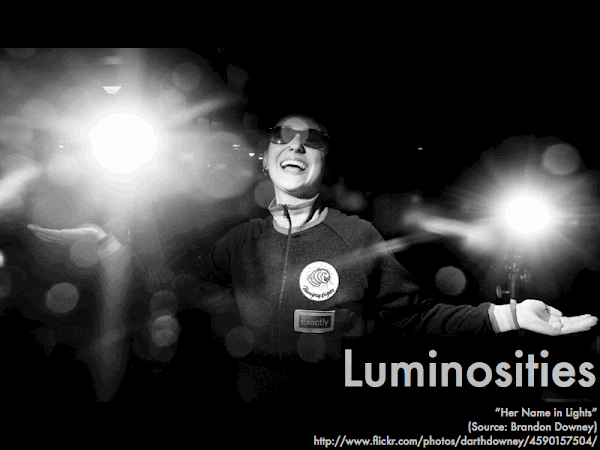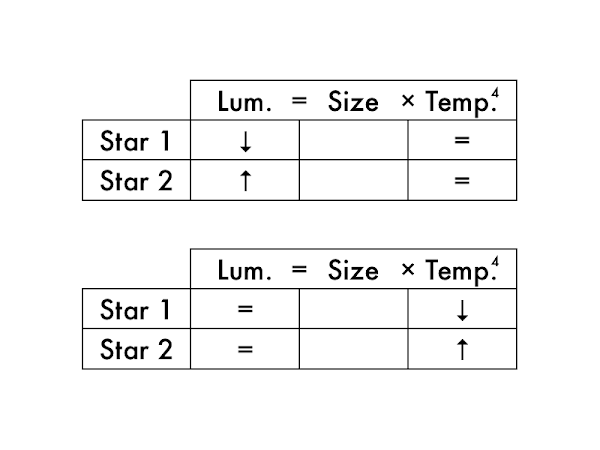Cuesta College, San Luis Obispo, CA
Students have a weekly online reading assignment (hosted by SurveyMonkey.com), where they answer questions based on reading their textbook, material covered in previous lectures, opinion questions, and/or asking (anonymous) questions or making (anonymous) comments. Full credit is given for completing the online reading assignment before next week's lecture, regardless if whether their answers are correct/incorrect. Selected results/questions/comments are addressed by the instructor at the start of the following lecture.
The following questions were asked on reading textbook chapters and previewing presentations on parallax, distance, apparent magnitude, absolute magnitude, Wien's law and the Stefan-Boltzmann law.

Selected/edited responses are given below.
Describe something you found interesting from the assigned textbook reading or presentation preview, and explain why this was personally interesting for you.
"That you can measure the temperature, mass, and distance of a star that is millions of miles away."
"The magnitude scale, because you would think that a 0 or a -1 on the scale would be the dimmest, not the brightest."
"The fact that stars are WAY farther than the sun and are still able to be seen clearly in the night sky."
"The average density of giants and supergiants. It seems counterintuitive that their density should be so low. Of course that's just 'average' density, and given the extreme size I guess it makes sense, but it's so odd."
"That you can tell how far away a star is based on the parallax because I think it is a really creative way to find the distance of a star."
"ROYGBIV is a lie."
Describe something you found confusing from the assigned textbook reading or presentation preview, and explain why this was personally confusing for you.
"Small versus large parallax shifts for stars and different distances."
"Parsecs because I'm not familiar with this type of measurement"
"Wein's Law is confusing me."
"H-R diagrams, I don't understand the correlation of all the data"
"How they can find the absolute magnitude of a star if all we see is its apparent magnitude."
"If two stars are the same brightness, will the cooler or hotter star be larger in size? I think they would be the same, but I'm not sure."
"The H-R diagram. It's new and unfamiliar. However the more I look it over the easier I'm able to interpret it."
"The relation between a star's size and its temperature and its brightness"
Explain how apparent magnitude and the absolute magnitude are defined differently.
"Apparent magnitude is how bright a star is to an observer on Earth, absolute magnitude is how bright the star would be if it were 10 parsecs away."
"Absolute is intinsic brightness, apparent is how it looks to us."
"Apparent is what we see and absolute is what it really is."
Suppose the sun was moved to a distance of 10 parsecs away. As a result, its __________ magnitude would become dimmer.
absolute. ************** [14] apparent. ************** [14] (Both of the above choices.) ** [2] (Neither of the above choices.) [0] (Unsure/guessing/lost/help!) [0]

(Only correct responses shown.)
1 (brightest): the sun, m = -27 [83%]
2: Canopus, m = –1 [80%]
3: Vega, m = 0 [90%]
4 (dimmest): Kapteyn's star, m = +9 [83%]
Rank the brightnesses of these stars (1 = brightest, 4 = dimmest; there are no ties), if relocated to 10 parsecs from Earth.
(Only correct responses shown.)
1 (brightest): Canopus, M = -3 [67%]
2: Vega, M = +0.5 [64%]
3: the sun, M = +5 [67%]
4 (dimmest): Kapteyn's star, M = +11 [73%]
Determine the stars that get dimmer or brighter when relocated from their original positions to 10 parsecs from Earth.
(Only correct responses shown.)
The sun: gets dimmer [77%]
Canopus: gets brighter [67%]
Vega: gets dimmer [40%]
Kapteyn's star: gets dimmer [40%]
Rank the temperatures of these main sequence stars (1 = hottest, 4 = coolest; there are no ties).
(Only correct responses shown.)
Hottest: blue main sequence star [90%]
Second hottest: white main sequence star [83%]
Third hottest: yellow main sequence star [90%]
Coolest: red main sequence star [90%]
Rank the temperatures of these supergiant and dwarf stars (1 = hottest, 4 = coolest; there are no ties).
(Only correct responses shown.)
Hottest: blue supergiant [83%]
Second hottest: white dwarf [70%]
Third hottest: yellow supergiant [73%]
Coolest: red dwarf [87%]

dimmer. ******* [7] brighter. ********************* [21] (These stars would be the same size.) * [1] (Unsure/guessing/lost/help!) * [1]
Two stars (equally far away) have the same brightness, but one star is cooler, and the other star is hotter. The __________ star will be larger in size.
cooler. ****************** [18] hotter. ********* [9] (These stars would be the same size.) ** [2] (Unsure/guessing/lost/help!) * [1]
Ask the instructor an anonymous question, or make a comment. Selected questions/comments may be discussed in class.
"It's funny how blue is often associated with cool and red is often associated with hot. Confusing when it comes to stars and that's all flipped around!"
"Would you rather be a supergiant or dwarf star?" (#sizemattersnot)
"You're a homie P-dog." (Word.)
"How many more extra credit opportunities will there be?" (Shh. It's a secret. But a few more.)
"What is the most fascinating part of astronomy for you?" (This stuff--star parameters, and how stars live and die.)
"Going over this information in class will be really helpful! I reiterate this each time but I read the information and sometimes understand what I read other times I don't. Going over it and having someone who know what they are talking about it explain it and discuss it helps me learn. Doing the in-class activities also give me the 'hands on' experience that also helps me grasp information."
"How can you tell the difference between a star that is blue because it is moving toward you and a star that is blue because it is really hot?" (Let's consider a white-hot star. It won't get noticeably blue-r if it moves towards you, or redder if it moves away from you--it will still essentially be white in appearance, but if you plot all of its absorption lines in a spectrum, they will all shift slightly to shorter or to longer wavelength values because of the Doppler effect, which is a very subtle effect for the speeds that stars can move at.)
"This class is great. I really enjoy the subject and your knowledge and instruction add to the experience. Thank you."
No comments:
Post a Comment